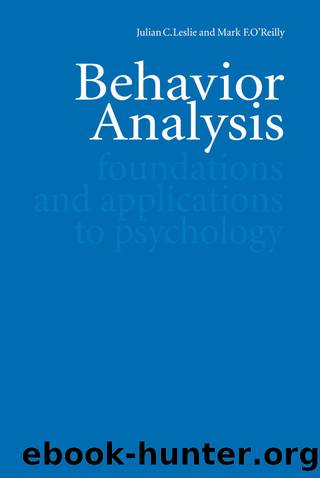Behavior Analysis: Foundations and Applications to Psychology by Julian C. Leslie & Mark F. O'Reilly

Author:Julian C. Leslie & Mark F. O'Reilly [Leslie, Julian C.]
Language: eng
Format: azw3
ISBN: 9781317762348
Publisher: Taylor and Francis
Published: 2016-01-20T00:00:00+00:00
7.7 Functional Assessment and Analysis of Aberrant Behavior
At the beginning of this chapter a model was presented that identified the important parameters to be considered when conducting an assessment of behavior. In addition to operationalizing the target behavior, this model emphasized an assessment of the environmental stimuli (both antecedent and consequent stimuli) that entered into functional relationships with that behavior. It is no accident that the majority of this chapter focuses on the strategies used to develop a clear identification of the target behavior. Until recently, applied behavior analysts have primarily been interested in isolating target behaviors and selecting interventions to increase or decrease the frequency of these behaviors. The behavior of applied behavior analysts themselves (in terms of the interventions they have selected) seems to have been controlled by the structure or topography of the target behaviors rather than by the operant function of these behaviors. For example, the target behavior might be "eye gouging", without reference to its function for the individual. This approach contradicts a fundamental premise of behavioral analysis which describes behavior primarily in terms of its function (see Chapter 1). These points do not detract from the importance of systematically identifying and operationalizing target behaviors. However, an analysis of the environmental determinants of target behaviors from a functional perspective has often been missing from the practice of behavioral assessment. The assessment of severe aberrant behavior is one notable exception to this. Over the last decade the majority of published studies that have examined aberrant behavior have conducted a functional assessment or analysis of the environmental determinants of target behaviors and subsequently matched a treatment to maintaining contingencies. It is therefore instructive to examine the assessment strategies developed in this particular area of applied behavior analysis.
The term functional assessment has been used to describe a variety of systematic procedures to determine antecedent and consequent variables which occasion and maintain aberrant behaviors. Functional assessment typically involves a process whereby target behaviors are defined by interviewing significant others and are subsequently observed in naturalistic contexts (in those contexts where the behavior has been described as being problematic). This form of assessment reveals correlational information regarding establishing/discriminative conditions and consequences for the target behavior. Assessment procedures may also involve the systematic manipulation of hypothesized controlling variables to empirically demonstrate causal relationships. This latter assessment technique is typically referred to as a functional analysis (Axelrod, 1987; Iwata, Dorsey, Slifer, Bauman, & Richman, 1982).
A knowledge of controlling variables derived from such assessment protocol assists in the development of effective treatment procedures in at least three ways (Lennox & Miltenburger, 1989). First, assessment may identify reinforcing consequences (positive or negative) contingent on target behavior performance which can subsequently be eliminated or prevented (Carr, Newsom, & Binkoff, 1980). This means that instead of the planned intervention "inventing" new contingencies to modify problem target behavior, it can change those that already control it. Second, an assessment may identify motivational (Michael, 1982; 1993) and/or discriminative (Skinner, 1935) conditions that evoke the target behavior, and by
Download
This site does not store any files on its server. We only index and link to content provided by other sites. Please contact the content providers to delete copyright contents if any and email us, we'll remove relevant links or contents immediately.
Rewire Your Anxious Brain by Catherine M. Pittman(18555)
Talking to Strangers by Malcolm Gladwell(13233)
The Art of Thinking Clearly by Rolf Dobelli(10234)
Mindhunter: Inside the FBI's Elite Serial Crime Unit by John E. Douglas & Mark Olshaker(9212)
Becoming Supernatural by Dr. Joe Dispenza(8127)
Change Your Questions, Change Your Life by Marilee Adams(7641)
Nudge - Improving Decisions about Health, Wealth, and Happiness by Thaler Sunstein(7622)
The Road Less Traveled by M. Scott Peck(7525)
The Lost Art of Listening by Michael P. Nichols(7412)
Enlightenment Now: The Case for Reason, Science, Humanism, and Progress by Steven Pinker(7242)
Mastermind: How to Think Like Sherlock Holmes by Maria Konnikova(7234)
Win Bigly by Scott Adams(7097)
The Way of Zen by Alan W. Watts(6512)
Daring Greatly by Brene Brown(6451)
Big Magic: Creative Living Beyond Fear by Elizabeth Gilbert(5617)
Grit by Angela Duckworth(5525)
Ego Is the Enemy by Ryan Holiday(5297)
Men In Love by Nancy Friday(5162)
Altered Sensations by David Pantalony(5048)
